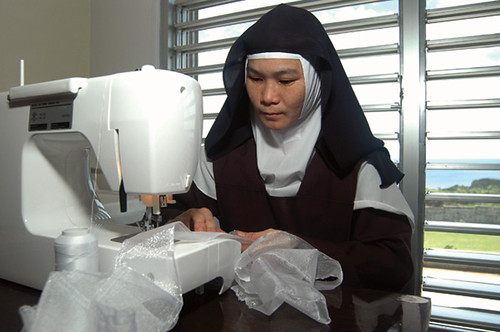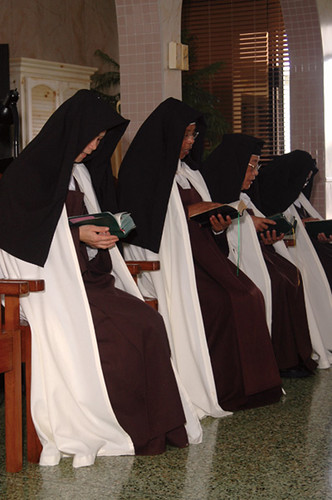Arrived on island in 1966, left in 2016
The Carmelite Sisters are an order of contemplative Catholic nuns who follow the reformed observance of the Carmelite Rule as defined by Saint Teresa of Avila. The Carmelites are so named because they were traditionally founded by Christian hermits on Mount Carmel in Palestine. The Carmelites are cloistered; that is, they do not leave the monastery except for medical needs and in other special circumstances, but remain within the monastery leading a life of quiet prayer and work.
The Carmelites were invited to Guam by the late Bishop Apollinaris Baumgartner, OFM Cap and arrived on island in 1966. The Carmelite pioneers in Guam were sent by the Carmelite Monastery of Kota Kinabalu, Malaysia, at the time known as Jesselton. Before their own monastery could be built, the original band of Carmelites lived with the Sisters of Mercy in Ta’i, Mangilao.
The Carmelites left Guam in 2016 after 50 years.
The Carmelites first built their monastery in Malojloj, Inalåhan and began to support themselves through the making and sale of communion wafers, baptismal gowns, wedding veils, Christmas decorations, and other such products. The monastery was dedicated on 14 January 1968. For some years they also maintained an egg farm.
Many local benefactors over the years also assisted the nuns. The parish of San Isidro was built in connection with the monastery. The nuns were often sought after in Malojloj for intercessory prayer and spiritual guidance.
The community was lead by a Prioress elected from among their number. Past prioresses have been Mothers Concepcion, Dolores, Josephine, Bernadette, and Dawn Marie.
In 1981, the Carmelites were given special permission to leave their cloister to participate in the historic visit of Pope John Paul II to the Dulce Nombre de Maria Cathedral-Basilica in Hagåtña. They were given front seats in the cathedral.
In December 2006, the community moved out of their Malojloj monastery to a house in Tamuning which was renovated into a monastery. The move was prompted by their decrease in size and their advanced age, necessitating more frequent visits to doctors and other health services mainly located in Tamuning and adjacent areas. In their urban setting, the Carmelites hoped to continue being a spiritual oasis in the midst of the commercial center of Guam.
Donation brings controversy
The Carmelite nuns anonymously donated $2 million to the Archdiocese of Agana to buy a former hotel in Yona in 2010 to be used as a seminary. When they found out that the seminary would be operated by the Neocatechumenal Way, they considering suing the archdiocese as that was not what they had intended.
Carmelite Mother Superior Dawn Marie told the local media that former Archbishop Anthony S. Apuron, the Rev. Pius Sammut and others in 2014 tried to get the Carmelites to lie, by saying the Carmelites had purposely earmarked their gift for the use of the Redemptoris Mater Seminary and for the Blessed Diego Luis de San Vitores Catholic Theological Institute for Oceania.
The Carmelites decided to leave Guam because of what the mother superior described as a “toxic environment” when Apuron agreed to put a deed of restriction on the Yona property in November 2011, as well as the multiple sex abuse allegations against Apuron.
The deed of restriction was lifted by the Archdiocese of Agana’s Coadjutor Archbishop Michael Jude Byrnes just days after the Carmelites made their decision to leave. The Neocatechumenal Way came to Guam in 1996 and Apuron became one of its members.
Pope Francis appointed Byrnes as coadjutor archbishop of the Archdiocese of Agana, which gave Byrnes the right to succeed Archbishop Apuron. He did so in 2019 and now serves as the Archbishop of the Archdiocese of Agana.
By Eric Forbes, OFM Cap. and Guampedia staff
For further reading
A Life of Prayer: Discalced Carmelite Nuns. “Welcome to Arlington Carmel.” Last modified 4 August 2022.




